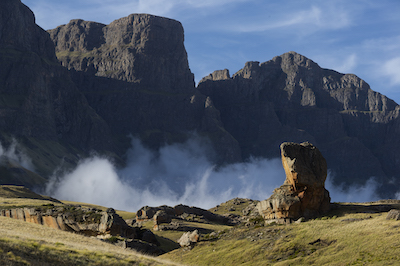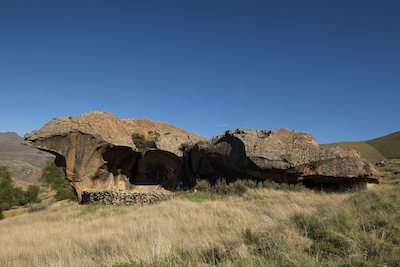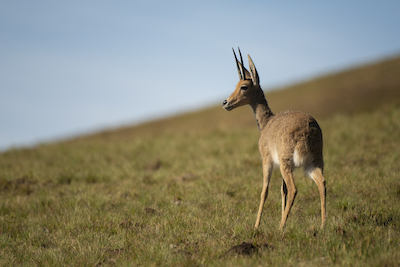
You are here: Explore > National Parks and Nature Reserves > Sehlabathebe National Park
Established in 1970 as Lesotho’s first national park, the fabulously scenic and remote Sehlabathebe protects 65 square kilometres of rolling boulder-studded grassland set below the uKhahlamba-Drakensberg escarpment as it runs along the border with South Africa.
 Set at an average altitude of 2,400 metres, Sehlabathebe - literally ‘Shield of the Plateau’ - is one of the most isolated and dramatic national parks anywhere in southern Africa. Its international importance was recognised in 2008 when UNESCO incorporated it into the cross-border Maloti-Drakensberg World Heritage Site. This is one of only two World Heritage Sites in sub-equatorial Africa to be classified as mixed, which means it is recognised for its cultural significance (in the form of abundant prehistoric rock art) as well as its diverse natural assets.
Set at an average altitude of 2,400 metres, Sehlabathebe - literally ‘Shield of the Plateau’ - is one of the most isolated and dramatic national parks anywhere in southern Africa. Its international importance was recognised in 2008 when UNESCO incorporated it into the cross-border Maloti-Drakensberg World Heritage Site. This is one of only two World Heritage Sites in sub-equatorial Africa to be classified as mixed, which means it is recognised for its cultural significance (in the form of abundant prehistoric rock art) as well as its diverse natural assets.
 A hiker’s paradise, Sehlabathebe is studded with weird and wonderful natural rock formations sculpted by the erosion of sandstone substrata below harder igneous rocks. Most spectacular, situated about 10km inside the main entrance gate close, is a fantastic giant’s playground of immense rock arches, caves, dolmen-like outcrops and clear rock pools set below the imposing trio of escarpment peaks known as the Devil’s Knuckles or Three Bushmen.
A hiker’s paradise, Sehlabathebe is studded with weird and wonderful natural rock formations sculpted by the erosion of sandstone substrata below harder igneous rocks. Most spectacular, situated about 10km inside the main entrance gate close, is a fantastic giant’s playground of immense rock arches, caves, dolmen-like outcrops and clear rock pools set below the imposing trio of escarpment peaks known as the Devil’s Knuckles or Three Bushmen.
Sehlabathebe is renowned for its wealth of wildflowers, which bloom most prolifically between November and February. Most notable among these is the white-and-yellow Sehlabathebe waterlily Aponogeton ranunculiflorus, an endangered buttercup-like endemic that grows in the muddy base of shallow sandstone rock pools.
 The park’s most abundant large mammal is the grey rhebok, a medium-sized white-tailed antelope frequently seen in grazing on the grassy slopes in pairs or small family groups. Other wildlife occasionally seen by hikers includes eland, oribi, baboon, rock hyrax and black-back jackal. The birdlife is dominated by Afromontane specials such as Cape vulture, jackal buzzard, Drakensberg rockjumper, yellow-breasted pipit and Drakensberg siskin. The surrounding mountains are a breeding site for the rare bearded vulture and the only place in southern Africa where the Egyptian vulture has been recorded in recent years.
The park’s most abundant large mammal is the grey rhebok, a medium-sized white-tailed antelope frequently seen in grazing on the grassy slopes in pairs or small family groups. Other wildlife occasionally seen by hikers includes eland, oribi, baboon, rock hyrax and black-back jackal. The birdlife is dominated by Afromontane specials such as Cape vulture, jackal buzzard, Drakensberg rockjumper, yellow-breasted pipit and Drakensberg siskin. The surrounding mountains are a breeding site for the rare bearded vulture and the only place in southern Africa where the Egyptian vulture has been recorded in recent years.
Hiking aside, Sehlabathebe can also be explored on horseback, and there is excellent trout fishing on the Tsoelikana River, where an attractive waterfall tumbles over a low cliff into a chilly natural swimming pool.
An incredible 65 rock art sites have been documented within Sehlabathebe National Park. The most accessible, and one of the best preserved, is signposted from the main road between the gate and the lodge. It includes several depictions of eland, a running herd of smaller antelope (probably springbok or hartebeest) and several human figures.
.jpg) Sleeping: A modern self-catering lodge offers comfortable accommodation on a scenic rise a couple of kilometres inside the main gate. Basic catered accommodation can be found a short distance outside the park.
Sleeping: A modern self-catering lodge offers comfortable accommodation on a scenic rise a couple of kilometres inside the main gate. Basic catered accommodation can be found a short distance outside the park.
Eating: There is no restaurant in the park, so visitors need to self-cater and to bring all the food and drink they require (including drinking water). Electric fridges and gas cookers are available in some lodge units.
Access: All approach roads to Sehlabathebe National Park are unsurfaced and require high clearance and ideally 4x4.
The best route, and the one usually used coming from Maseru, involves following the surfaced A5 southeast via Semonkong to Qacha’s Nek (225km, four hours) then branching northeast on to a fair unsurfaced road (90km, 2-3 hours) that runs close to the South African border as it approaches the park gate. This road may be surfaced in the near future.
Coming from Sani Top, it is only 200km to Sehlabathebe using a back route that involves following the surfaced A1 northwest almost as far as Mokhotlong then taking a succession of unsurfaced roads that deteriorate as you get closer to the gate. GPS Is useful for this route, and you should allow at least eight hours for the drive.
Hikers could consider approaching the park on foot from Sani Top, following a 40km, three-day footpath along the escarpment. This route can also be done on horseback by prior arrangement. In either case, an experienced local guide and/or GPS and detailed maps are a prerequisite.
Preparations: The lodge in Sehlabathebe National Park often goes days without custom so it is worth calling in advance to book and establish whether it currently has electricity gas and running water. No firewood is available locally so bring charcoal if you intend to barbecue. Good walking shoes and warm clothes for the chilly highland evenings are also recommended.


